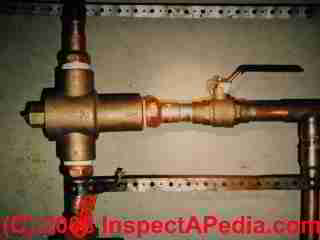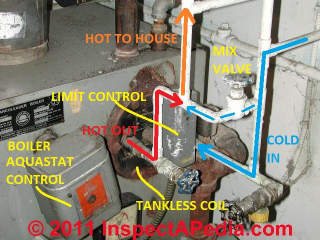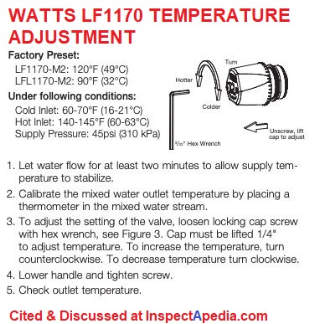 Manually-Operated Temperature Mixing Valves & Anti Scald Valves
Manually-Operated Temperature Mixing Valves & Anti Scald Valves
For domestic hot water supply
- POST a QUESTION or COMMENT about anti scald devices and mixing valves on hot water systems
Manually-operated anti-Scald valves used at heating boilers or at stand-alone hot water cylinders, geysers, or water heaters:
This article describes a simple manually-operated control that is set to mix cold in with outgoing hot water to avoid risking a scalding burn for building occupants who use hot water.
We warn that depending on the hot water source (a water geyser or hot water cylinder or hot water heater versus a tankless coil at a heating boiler) you may need to adjust this valve at the start and end of the heating season to avoid hot water burns.
In this article series we explain how to buy, install, adjust and inspect anti-scald equipment to prevent hot water burns. We explain what a mixing valve, tempering valve, or anti-scald valve is, where and why these valves are installed on hot water systems, and how they work.
InspectAPedia tolerates no conflicts of interest. We have no relationship with advertisers, products, or services discussed at this website.
Guide to Using a Manual Hot Water Tempering Valve on the Domestic Hot Water Supply
By manual hot water tempering valve we mean that the plumber has installed an ordinary plumbing valve and a cold water bypass pipe to mix some cold water into the water heater's outgoing hot water supply. This valve must be adjusted by the building occupant to obtain the desired temperature.
Our photo shows a manual mixing valve (a gate valve) that is opened to add cold to outgoing hot from the tankless coils water heater. The valve in the center-right of the photo allows cold water to be added to the hot water leaving the coil. (The copper pipes were painted white - don't ask.)
[Click to enlarge any image]
Article Contents
A manual tempering valve does not respond to changing conditions on its own.
Watch out: a manual-only mixing valve is inherently an unsafe or unreliable means of scald burn protection. Water temperatures produced by the water heater may change for a variety of reasons surprising and even burning building occupants.
Which Way to Turn a Manual Anti-Scald Valve or non-Automatic Mixing Valve to Control Hot Water Temperature
 By "manual" mixing valve we mean that an ordinary plumbing valve, usually a gate valve or ball valve is used to adjust outgoing hot water temperature, and the building occupants have to adjust the valve by hand, "manually".
By "manual" mixing valve we mean that an ordinary plumbing valve, usually a gate valve or ball valve is used to adjust outgoing hot water temperature, and the building occupants have to adjust the valve by hand, "manually".
In most cases a manual hot water mixing or tempering valve (discussed below) will work oppositely from many models of the automatic tempering valves discussed above.
On a manual mixing valve or "tempering valve" if we "close" the manual valve by turning it clockwise we are are admitting less cold water into the mixing process, thus making the output water temperature hotter at plumbing fixtures in the building.
Here is a manual mixing valve on a hydronic heating system.
You may find a ball-valve like this controlling domestic hot water temperature, radiant floor heating temperature, or even individual heating zone water temperature.
This manually controlled valve (a human has to turn it) feeds some cold water into the hot water that is piped to building plumbing fixtures.
So, for a manually operated tempering or mixing valve,
- Opening (turning counter-clockwise) a manual mixing valve mixes in more cold water and makes the resulting "hot water" in the building cooler - it lowers the temperature of the outgoing hot water.
- Closing (turning clockwise, or "in" or "down" or "closed") a manual mixing valve mixes in less cold water so it makes the resulting "hot water" in the building hotter - it raises the hot water temperature.
When Should We Adjust a Manual Hot Water Tempering or Mixing Valve?
Hot Water Made by a Tankless Coil & Heating Boiler - Manual Adjustment of Tempering Valve
Watch out: if your hot water system uses a manual tempering valve and your hot water is made by a tankless coil and a hot water or steam heating boiler (as opposed to a separate hot water heater and tank), you will want to manually adjust the valve to produce a safe (below scalding temperature) hot water temperature measured at the plumbing fixture located closest to the hot water source (the heating boiler).
During the heating season
when the boiler is hotter, you'll want to adjust the valve again to prevent the hot water temperature from being too high. In sum, you'll need to change the manual mixing valve setting twice a year.
At the end of the heating season,
when the same heating boiler continues its job of making domestic hot water at a tankless coil or side-arm coil, you will need to adjust the manual tempering valve again to close off some of the mixed-in cold so that your water temperature is hot enough.
That's because on most heating boilers using an aquastat or even separate individual boiler temperature controls, the boiler remains at a lower temperature when the building thermostats are never calling for heat.
Hot Water Made by a Separate Water Heater Using a Manually-Adjusted Tempering Valve
A second reason you may need to adjust the manual hot water mixing valve is that in some areas the temperature of the cold water entering the building may vary by season.
Even if your hot water is made by a separate hot water heating tank, your system might have a manual mixing valve installed and you might need to adjust that setting seasonally as incoming water temperatures change.
More information about tankless coils, how they work, what goes wrong, and their controls, is at TANKLESS COILS.
See WATER PIPE CLOG REPAIR for a discussion of loss of water pressure due to clogged piping or clogged tankless coils.
...
Continue reading at POINT of USE BUILT-IN FIXTURE ANTI-SCALD VALVES or select a topic from the closely-related articles below, or see the complete ARTICLE INDEX.
Or see these
Recommended Articles
- ANTI SCALD VALVES & TEMPERATURE CONTROL / MIXING VALVES - home
- ANTI-SCALD VALVE INSPECTION
- MANUAL HOT WATER TEMPERATURE CONTROLS - more on how to adjust hot water temperature
- MIXING VALVE USE on RADIANT HEATING SYTEMS
- POINT of USE BUILT-IN FIXTURE ANTI-SCALD VALVES
- WATER HEATER TEMPERATURE TOO COLD or TOO HOT
- HOT WATER QUANTITY IMPROVEMENT - If you do not have enough hot water pressure or hot water quantity
- WATER HEATER TEMPERATURE ADJUSTMENT CONTROLS - home
Suggested citation for this web page
MANUAL ANTI-SCALD TEMPERING VALVES at InspectApedia.com - online encyclopedia of building & environmental inspection, testing, diagnosis, repair, & problem prevention advice.
Or see this
INDEX to RELATED ARTICLES: ARTICLE INDEX to WATER HEATERS
Or use the SEARCH BOX found below to Ask a Question or Search InspectApedia
Ask a Question or Search InspectApedia
Questions & answers or comments about anti scald devices and mixing valves on hot water systems
Try the search box just below, or if you prefer, post a question or comment in the Comments box below and we will respond promptly.
Search the InspectApedia website
Note: appearance of your Comment below may be delayed: if your comment contains an image, photograph, web link, or text that looks to the software as if it might be a web link, your posting will appear after it has been approved by a moderator. Apologies for the delay.
Only one image can be added per comment but you can post as many comments, and therefore images, as you like.
You will not receive a notification when a response to your question has been posted.
Please bookmark this page to make it easy for you to check back for our response.
Our Comment Box is provided by Countable Web Productions countable.ca
Citations & References
In addition to any citations in the article above, a full list is available on request.
- Watts Series LF1170 and LFL1170 Hot Water Temperature Control Valves SPECIFICATIONS [PDF] (2019), Watts Regulator Co. (2013), USA Tel: (978) 688-1811, Fax: (978) 794-1848,
Website: www.watts.com,
Canada: Tel: (905) 332-4090, Fax: (905) 332-7068, Website: www.watts.ca - Watts Series LF1170 and LFL1170 Hot Water Temperature Control Valves INSTALLATION INSTRUCTIONS [PDF] Installation, operating, and adjustment instructions for the LF1170 and LFL1170 mixing valves.
- "BDS Series Oil-Fired Hot Water Boilers, Installation Instructions, Models GS-080 -> Crown BDS-236", Crown Boiler Company, BDS 12-99, Crown Boiler Co. P.O. Box 14818 3633 I Street, Philadelphia, PA 19134 (215) 535-8900, Website: http://www.crownboiler.com, retrieved 2/26/2014, original source: http://www.crownboiler.com/manuals/content/ All_Models/BDS%20Series%20%28all%20models%29.pdf
The following link provides access to literature or manuals for previous Crown products:
http://www.crownboiler.com/Support/Manuals-And-Literature/Previous-Products - A.O. Smith water heater safety sticker: 182734-000 Rev.00 observed on the gas fired water heater shown at High Efficiency Gas Water Heaters
- Thanks to Bruce Jones, Renewable Energy Solutions Manager, for suggesting clarifications about which way to turn the mixing valve to make water supply hotter or colder. email August 2010.
- Thanks to reader J.S.A. for discussing hot water mixing valves and which way to turn the valve - July 2010
- Thanks to reader Athena for discussing hot water mixing valves and which way to turn the valve to make water hotter or cooler - October 2010.
- Thanks to reader Chris Martino for pointing out inconsistent text about which way to turn the hot water mixing valve or tempering valve. December 2010.
- Thanks to reader Bob for discussing clarifications needed to text about which way to turn the hot water mixing valve. January 2011.
- "Domestic Hot Water Scald Burn Lawsuits, The Who, What, When, Why, Where, How", Dr. D. Bynum Jr., Vernon L. Petri, Esq., John T. Myers, paralegal, Seminar and Technical Paper for the 25-28 Oct 98 Annual ASPE Meeting at the Indianapolis Convention Center, Indianapolis IN, websearch 09/21/2010,original source: http://media.wattswater.com/F-H20LS-Reprint.pdf [Large PDF]
- [5] "Water Saving Tips: For Residential Water Use, Indoors and Out", Alliance for Water Efficiency, 300 W Adams Street, Suite 601 Chicago, Illinois 60606, Tel: 773-360-5100, 866-730-A4WE, Email: jeffrey@a4we.org, web search 12/14/11, original source: plumbingefficiencyresearchcoalition.org/
- [6] "Danger in the Shower: 2008 Forum Looks at Hot Water", John Koeller, Home Energy, Jan/Feb 2009, Home Energy Magazine, 1250 Addison Street Suite 211B, Berkeley, Ca. 94702, Tel: (510) 524-5405 Email: contact@homeenergy.org
- In addition to citations & references found in this article, see the research citations given at the end of the related articles found at our suggested
CONTINUE READING or RECOMMENDED ARTICLES.
[Click to enlarge any image]
- Carson, Dunlop & Associates Ltd., 120 Carlton Street Suite 407, Toronto ON M5A 4K2. Tel: (416) 964-9415 1-800-268-7070 Email: info@carsondunlop.com. Alan Carson is a past president of ASHI, the American Society of Home Inspectors.
Thanks to Alan Carson and Bob Dunlop, for permission for InspectAPedia to use text excerpts from The HOME REFERENCE BOOK - the Encyclopedia of Homes and to use illustrations from The ILLUSTRATED HOME .
Carson Dunlop Associates provides extensive home inspection education and report writing material. In gratitude we provide links to tsome Carson Dunlop Associates products and services.



